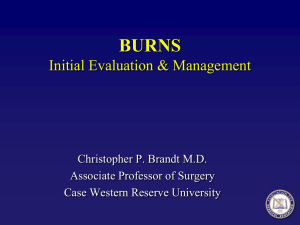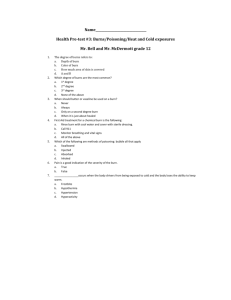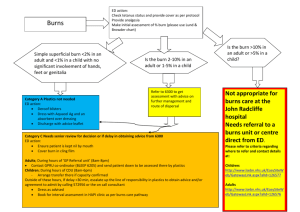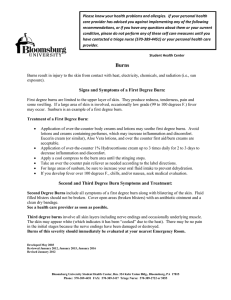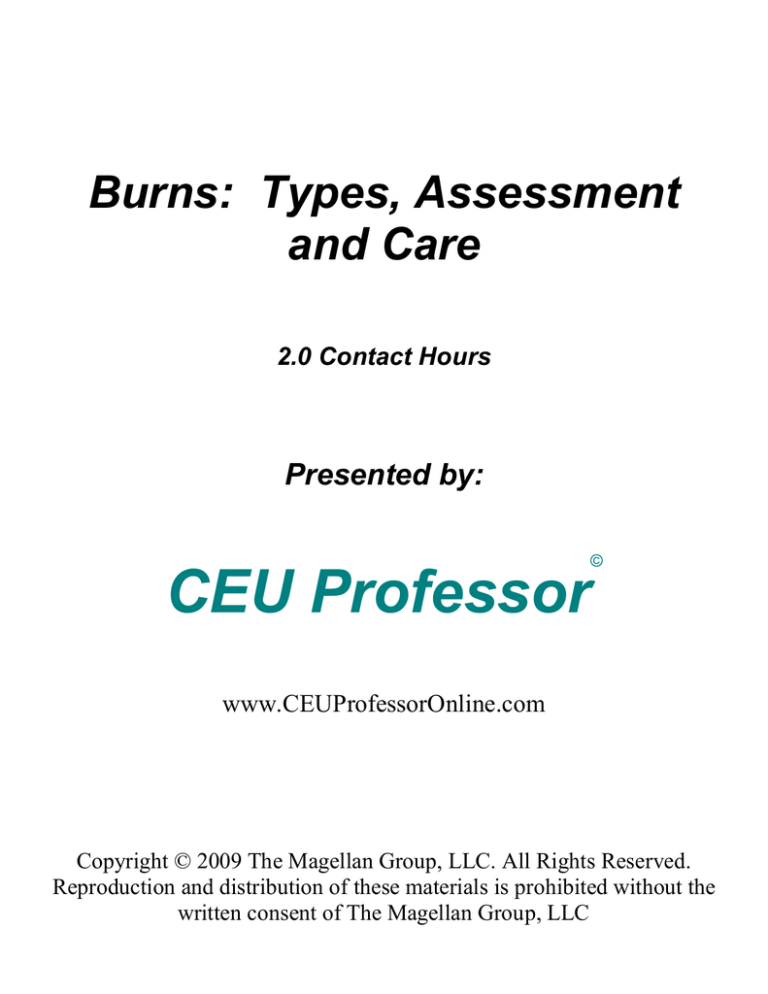
Burns: Types, Assessment
and Care
2.0 Contact Hours
Presented by:
CEU Professor
©
www.CEUProfessorOnline.com
Copyright © 2009 The Magellan Group, LLC. All Rights Reserved.
Reproduction and distribution of these materials is prohibited without the
written consent of The Magellan Group, LLC
Burns: Types, Assessment and Care
By Mary Dunay RN
Objectives:
At the completion of this course, the learner will be able to:
1. Recognize the pathophysiology of thermal burns.
2. Specify burn assessment.
3. Identify resuscitative interventions for burns.
4. Identify criteria for referral to a burn center.
Introduction
The American Burn Association estimates that 500,000 people seek medical care for
burns and 50,000 are hospitalized yearly. Medical care for burns has progressed to
include burn fluid resuscitation, an improvement in care that has accounted for the
reduced mortality rate of patients with burns.
Pathophysiology
A thermal burn is an injury to the skin caused by heat reaching at least 113o F (45oC).
The area of the skin that receives the greatest amount or duration of heat is the zone of
coagulation. In this zone, proteins coagulate, cells die, and the tissue is charred, white, or
cream-colored and will not blanch. Surrounding this area is the zone of stasis in which
injury varies according to the interruption of blood flow to the tissue. Tissue is red, will
not blanch, and may die within 24 hours if fluid resuscitation does not occur. The
outermost area of the burn is the zone of hyperemia. Tissue damage in this zone is
minimal. The skin is red, blanches, and recovers quickly.
When burns occur, injured cells release mediators that cause increased blood vessel wall
permeability. This allows blood components smaller than a red blood cell to escape into
the tissues around the burn. Sodium and plasma proteins leak into the tissues leaving the
blood very concentrated and viscous. Intracellular sodium, water, potassium,
magnesium, and phosphate imbalances occur. In addition, heat causes collagen fibers to
break down, allowing skin cells to expand to many times their normal size with edema.
The cell membranes are damaged and unless proper fluid resuscitation is given, the cell
will burst and die. Hyperkalemia results when cells burst releasing potassium. Fluid loss
peaks within 6 to 12 hours after the burn, and then capillary walls begin to recover.
Depending on where the burns occur, edema can cause loss of airway, pulmonary edema,
abdominal compartment syndrome, or ischemia of an extremity. Systemic inflammatory
response syndrome and septic shock can also occur during this time as complications of
burns that exceed 15 to 20% surface area.
If aggressive fluid resuscitation is not given promptly for serious burns, a cascade of
events occurs that will ultimately be fatal. Hypovolemia results in decreased tissue and
organ perfusion throughout the body, especially the skin, gastrointestinal tract, and
kidneys. Metabolic acidosis occurs as a result of anaerobic metabolism caused by the
decreased blood flow. Abdominal compartment syndrome can cause myoglobinuria,
oliguria, ileus, abdominal distension, hypotension, and decreased pulmonary compliance.
Burns propel the metabolism of the body into overdrive which requires the body to
increase its oxygen consumption. Hypermetabolism results in muscle wasting, a negative
nitrogen and potassium balance, glucose intolerance, hyperinsulinemia, insulin resistance,
and retention of sodium.
Types of Burns
In addition to thermal burns described above, chemicals can also cause burns. Those that
do so include:
•
•
•
•
•
•
Strong acids such as sulfuric (toilet and other cleaners), hydrofluoric (glass etching
fluid), and muriatic acids (pool cleaner)
Alkalis such as potassium or sodium hydroxide (oven and drain cleaners), ammonia
(detergents), and lime (cement)
Corrosives such as lye, white phosphorus (fireworks), and phenol (disinfectants)
Oxidizing agents such as potassium permanganate (disinfectants) and chromic acid
(waterproofing agent)
Vesicants such as those used for chemical warfare including sulfur and nitrogen
mustards
Protoplasmic poisons such as hydrochloric (toilet cleaner), formic (airplane glue), and
tannic acids
Most acids cause coagulation necrosis of the skin; alkalis cause liquefaction necrosis.
The extent of injury depends on the pH, strength, and amount of the chemical and the
length of time that it is on the skin. Systemic effects of the chemical can occur. Some
chemicals cause severe heat when diluted so it is important to know how to flush the skin
to remove the chemical so that a thermal burn is not added to the chemical one.
Adequate flushing can take hours and should be done until pH is normalized. Some
chemicals require neutralization. Pain may occur later and radiate from deep within the
burn depending on the chemical. Care is the same as for thermal burns.
Electrical burn injuries depend on the amperage, voltage, type of current, path of current,
duration of contact, amount of skin in contact, and tissue resistance. Contact with
electricity causes coagulation necrosis as the electricity is converted to heat. Wounds are
usually small but tissue damage extends deeply into a large tissue area below the wound
creating a full-thickness (formerly third degree) burn. Nerves, muscles, and blood
vessels are damaged and bone fractures from tetany may also be present.
Ultraviolet radiation from the sun, tanning booths and beds, phototherapy, and arc lamps
can cause burns. Blood vessels dilate causing skin to turn red. Mediators are released by
cells an hour after exposure, initiating the inflammatory reaction which damages skin
cells further. Infrared and ionizing radiation also cause burns by causing breakage in
cellular DNA and by programming the cell's early death. Beta radiation used in cancer
radiation can cause burns to the skin, called "Beta burns".
Burn Assessment
Burn assessment determines the location of all burns, the classification of each burned
area, and the amount of body surface that is burned. Special care is taken to identify
entry and exit wounds caused by electricity. Remember that the internal injury under
such wounds is usually much larger than the surface wound suggests and may not be
revealed for hours or even days.
Burns are classified according to depth of injury. Burn depth is not always apparent until
hours or days later when ischemic tissue is identified and removed. Burns tend to be
more severe in children and the elderly because their skin is thinner. Burns are classified
as follows:
•
•
•
•
Superficial partial-thickness (formerly first-degree) - The burn involves the
epidermis. The skin is red, may be puffy, and does blanch. Pain is minor, itching
occurs with healing. Healing takes 5 days or less.
Moderate partial-thickness (formerly second-degree) - The burn is down to the
superficial dermal zone of the skin. The skin is red or mottled, weeping, and does
blanch. Pain is severe. Healing takes 3 weeks.
Deep partial-thickness (formerly still second degree) - The burn goes down to the
deep dermal zone. The skin is pink to cream-colored, may be blistered or dry, and
does not blanch. Pain varies from mild to severe. Healing takes 6 weeks.
Full-thickness (formerly third degree) - The burned area extends through the dermal
layer to involve the fat, muscle, and bone below. The skin is white, red, black, or
brown, dry and hard, and caved in. Pain is deep and aching. Burn requires grafting
to heal which takes more than a month.
The amount of body surface area burned is calculated in various ways. If burns are
spotty, use the area of the patient's palm as 1% to estimate size. Another way to estimate
is to use the Rule of Nines method. It can be done rapidly to provide estimations used
for fluid resuscitation. This method assigns percentages to different parts of the body:
•
•
•
•
•
•
Head and neck = 9%
Upper extremities= 9% each
Anterior thorax=18%
Posterior thorax =18%
Lower extremity=18%
Genitalia=1%
Children have larger heads in proportion to their body so the head and neck region is
assigned 18% and the lower extremities are reduced to 14% each; the rest of the body
areas correspond to the adult version.
The Lund and Browder formula is more complicated and specific and takes longer to
perform. A table lists areas of the body and provides the percentage of the total body
surface each area represents at various ages. This table is used at burn centers for more
precise calculations.
Resuscitative care
When a patient with burns presents for treatment, a rapid primary evaluation is performed
to assess the following:
•
•
•
•
•
•
Airway
Breathing
Circulation
Disability
Exposure
Fluid requirements
When there are burns around the facial area or a suspicion of inhalation injury, edema can
quickly compromise the airway. Intubation must be prompt, with emergency
cricothyrotomy performed if unable to intubate. The airway must be secured and
ventilation begun with 100% humidified oxygen.
Circulation is supported by starting two intravenous catheters of 14 to 16 gauge. Fluid
requirements must be calculated using the percentage of the body surface that has at least
a partial-thickness (second degree) burn. There is more than one fluid guideline in use
for fluid resuscitation of burn patients. One guideline calls for:
•
•
•
Adults-2 to 4 ml of Lactated Ringers x kilogram of body weight x percentage of body
surface area burned over 24 hours
Children- 3 to 4 ml of Lactated Ringers x kilogram of body weight x percentage of
body surface area burned over 24 hours
Infants and toddlers-Give the above calculated amount of Lactated Ringers for
children and add a piggyback of D5W at a maintenance rate.
One-half of the calculated fluid needs of the patient are given within the first 8 hours after
injury, with the remaining given over the next 16 hours. Fluid requirements are adjusted
during this time according to urine output and the patient's cardiovascular response. A
urinary catheter is inserted if the burn covers >20% or there are burns in the genital area
so urine output can be accurately measured. If burns are less than 15%, rehydration can
be partially via the oral route. Early enteral feedings may be considered at this time also.
Colloids may be given when >40% of the body surface is burned, there is preexisting
heart disease or inhalation injury, or the patient is elderly. Whether or not to give
colloids such as albumin, Dextran, fresh frozen plasma, or hypertonic saline during fluid
resuscitation is being debated as is the amount that should be given. Research on burn
resuscitation continues to define the benefits and administration of colloids and also seeks
a way to decrease the amount of mediators that are released by burned tissues.
Soon after admission, any burning, smoldering clothing is removed and any chemicals on
the skin are rinsed away. Clothing and jewelry are then removed. Wounds are covered
with sterile dry dressings or dry sheets if the burned areas are large. Wet saline dressings
can chill the patient and should not be used. Tetanus immune status is ascertained and
tetanus immunization is administered if needed.
The temperature is taken, monitors are applied, and the patient is kept warm. A
nasogastric tube may be inserted if the patient is intubated, burns are more than 20% of
body surface area, or nausea and vomiting is present. Intravenous pain medication is
given, usually morphine sulfate. Medication for anxiety may also be given.
When the primary interventions are initiated and ongoing, the secondary survey begins.
This survey may be done after the patient is transferred to the intensive care unit or to the
burn center. It covers assessment of the systems and is burn-specific:
•
•
•
•
•
•
Neurological-Assess level of consciousness, injuries caused by anoxia or carbon
monoxide inhalation, pain, and anxiety.
Head and throat-Check the eyes and ears for burn injuries or foreign bodies.
Cardiovascular-Check the chest for breathing restrictions due to burns and edema,
evaluate for inhalation injury and give bronchodilators if appropriate. Signs of
inhalation injury include singed skin around or in the mouth, smoky odor to breath,
cough, hoarseness, wheezes or crackles with respirations, dyspnea, black sputum, and
chest pain.
Gastrointestinal-Check for burns and developing abdominal compartment syndrome:
inability to ventilate with decreasing urine output.
Genitourinary-Assess for burns and need for catheter, assess burns on penis and
edema that can cause the uncircumcised foreskin to become trapped below the head
of the penis causing constriction (paraphimosis).
Musculoskeletal-Assess peripheral pulses, sensation, and movement. Monitor for
compartment syndrome if burns are circumferential.
Referral to Burn Centers
American Burn Association Guidelines state that the following burn injuries should be
referred to a burn center for care after the patient is stabilized:
• Partial-thickness burns over 10% of body surface
• Burns on face, hands, feet, genitalia/perineum, or joints
•
•
•
•
•
•
•
•
•
All full thickness (third degree) burns
All electrical burns including lightning
All chemical burns
All inhalation injury
Burn patients with other diseases
Trauma patients with severe burns
Burned children
Burn patients with social and emotional needs
Burn patients who need rehabilitation
Acute Burn Care
Fluid resuscitation is usually complete within 24 to 30 hours after the burn occurs. Urine
output is stabilized at 30 to 50 ml/hr. Vital sign trends slowly show a return towards
normal. Abnormalities in serum electrolytes and albumin are corrected. Continued
albumin infusions may be used to keep tissue edema controlled and to improve
gastrointestinal functioning.
Burn care involves cleansing, debridement, and application of antimicrobial creams.
Devitalized tissue must be removed for healing to occur and to prevent the restriction of
blood flow in the case of an extremity burn, especially if the burn encircles the limb.
Ongoing burn evaluation is performed to guide treatment and monitor for infections.
Skin grafting or application of artificial skin may be used to cover large burns.
Pain management is a priority. Nutrition must be supported to allow burn healing to
occur. Serum glucose is closely monitored and controlled with insulin administration.
Prolonged respiratory support may be needed if inhalation injury is present.
Complications such as systemic inflammatory response syndrome, infection, or septic
shock are prevented if possible or treated if they occur.
Psychological support is needed as the patient recovers and begins to cope with an altered
appearance and any resulting disabilities. Rehabilitation begins when the patient's
medical condition is stabilized. Physical, occupational, and speech therapy may be
required. Family counseling and financial support is also needed at this time.
References
Alspach JG, ed. Core Curriculum for Critical Care Nursing, 6th ed. St. Louis, MO;
Saunders Elsevier; 2006: 792-809.
American Burn Association. Burn Incidence and Treatment in the US: 2007 Fact Sheet.
Retrieved March 23, 2009. Available at
http://www.ameriburn.org/resources_factsheet.php
American Burn Association. Guidelines for the Operation of Burn Centers. Retrieved
March 23, 2009. Available at http://www.ameriburn.org/Chapter14.pdf
Caron A, McStay CM. Sunburn. Retrieved March 23, 2009. Available at
http://emedicine.medscape.com/article/773203-print
Cox, RD. Burns, Chemical. Retrieved March 26, 2009. Available at
http://emedicine.medscape.com/article/769336-print
Kis E, Kemeny L. Burns, Electrical. Retrieved March 26, 2009. Available at
http://emedicine.medscape.com/article/1089890-print
Newberry L, Criddle LM, eds. Sheehy's Manual of Emergency Care, 6th ed. St. Louis,
MO: Elsevier Mosby; 2005: 762-772.

